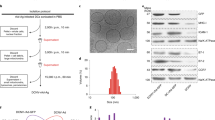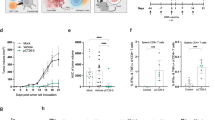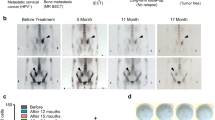Abstract
A novel method for generating an antigen-specific cancer vaccine and immunotherapy has emerged using a DNA vaccine. However, antigen-presenting cells (APCs) have a limited life span, which hinders their long-term ability to prime antigen-specific T cells. Connective tissue growth factor (CTGF) has a role in cell survival. This study explored the intradermal administration of DNA encoding CTGF with a model tumor antigen, human papilloma virus type 16 E7. Mice vaccinated with CTGF/E7 DNA exhibited a dramatic increase in E7-specific CD4+ and CD8+ T-cell precursors. They also showed an impressive antitumor effect against E7-expressing tumors compared with mice vaccinated with the wild-type E7 DNA. The delivery of DNA encoding CTGF and E7 or CTGF alone could prolong the survival of transduced dendritic cells (DCs) in vivo. In addition, CTGF/E7-transduced DCs could enhance a higher number of E7-specific CD8+ T cells than E7-transduced DCs. By prolonging the survival of APCs, DNA vaccine encoding CTGF linked to a tumor antigen represents an innovative approach to enhance DNA vaccine potency and holds promise for cancer prophylaxis and immunotherapy.
This is a preview of subscription content, access via your institution
Access options
Subscribe to this journal
Receive 12 print issues and online access
$259.00 per year
only $21.58 per issue
Buy this article
- Purchase on Springer Link
- Instant access to full article PDF
Prices may be subject to local taxes which are calculated during checkout






Similar content being viewed by others
References
Smith HO, Tiffany MF, Qualls CR, Key CR . The rising incidence of adenocarcinoma relative to squamous cell carcinoma of the uterine cervix in the United States—a 24-year population-based study. Gynecol Oncol 2000; 78: 97–105.
Mohar A, Frias-Mendivil M . Epidemiology of cervical cancer. Cancer Invest 2000; 18: 584–590.
Bosch FX, Manos MM, Munoz N, Sherman M, Jansen AM, Peto J et al. Prevalence of human papillomavirus in cervical cancer: a worldwide perspective. International biological study on cervical cancer (IBSCC) Study Group. J Natl Cancer Inst 1995; 87: 796–802.
Heard I, Tassie JM, Schmitz V, Mandelbrot L, Kazatchkine MD, Orth G . Increased risk of cervical disease among human immunodeficiency virus-infected women with severe immunosuppression and high human papillomavirus load. Obstet Gynecol 2000; 96: 403–409.
Chen CH, Ji H, Suh KW, Choti MA, Pardoll DM, Wu TC . Gene gun-mediated DNA vaccination induces antitumor immunity against human papillomavirus type 16 E7-expressing murine tumor metastases in the liver and lungs. Gene Ther 1999; 6: 1972–1981.
Chen TM, Chen YH, Wu CC, Chen CA, Chang CF, Hsieh CY . Factors influencing tumor cell kinetics in cervical cancer. J Cancer Res Clin Oncol 1996; 122: 504–508.
Lin HH, Cheng WF, Chan KW, Chang DY, Chen CK, Huang SC . Risk factors for recurrence in patients with stage IB, IIA, and IIB cervical carcinoma after radical hysterectomy and postoperative pelvic irradiation. Obstet Gynecol 1996; 88: 274–279.
Chang TC, Lai CH, Hong JH, Hsueh S, Huang KG, Chou HH et al. Randomized trial of neoadjuvant cisplatin, vincristine, bleomycin, and radical hysterectomy versus radiation therapy for bulky stage IB and IIA cervical cancer. J Clin Oncol 2000; 18: 1740–1747.
Boon T, Cerottini JC, Van den Eynde B, van der Bruggen P, Van Pel A . Tumor antigens recognized by T lymphocytes. Annu Rev Immunol 1994; 12: 337–365.
Chen CH, Wu TC . Experimental vaccine strategies for cancer immunotherapy. J Biomed Sci 1998; 5: 231–252.
Condon C, Watkins SC, Celluzzi CM, Thompson K, Falo Jr LD . DNA-based immunization by in vivo transfection of dendritic cells. Nat Med 1996; 2: 1122–1128.
Porgador A, Irvine KR, Iwasaki A, Barber BH, Restifo NP, Germain RN . Predominant role for directly transfected dendritic cells in antigen presentation to CD8+ T cells after gene gun immunization. J Exp Med 1998; 188: 1075–1082.
Cheng WF, Hung CF, Chai CY, Hsu KF, He L, Ling M et al. Tumor-specific immunity and antiangiogenesis generated by a DNA vaccine encoding calreticulin linked to a tumor antigen. J Clin Invest 2001; 108: 669–678.
Cheng WF, Hung CF, Chen CA, Lee CN, Su YN, Chai CY et al. Characterization of DNA vaccines encoding the domains of calreticulin for their ability to elicit tumor-specific immunity and antiangiogenesis. Vaccine 2005; 23: 3864–3874.
Hung CF, Cheng WF, He L, Ling M, Juang J, Lin CT et al. Enhancing major histocompatibility complex class I antigen presentation by targeting antigen to centrosomes. Cancer Res 2003; 63: 2393–2398.
Bradham DM, Igarashi A, Potter RL, Grotendorst GR . Connective tissue growth factor: a cysteine-rich mitogen secreted by human vascular endothelial cells is related to the SRC-induced immediate early gene product CEF-10. J Cell Biol 1991; 114: 1285–1294.
Gygi D, Zumstein P, Grossenbacher D, Altwegg L, Luscher TF, Gehring H et al. Human connective tissue growth factor expressed in Escherichia coli is a non-mitogenic inhibitor of apoptosis. Biochem Biophys Res Commun 2003; 311: 685–690.
Croci S, Landuzzi L, Astolfi A, Nicoletti G, Rosolen A, Sartori F et al. Inhibition of connective tissue growth factor (CTGF/CCN2) expression decreases the survival and myogenic differentiation of human rhabdomyosarcoma cells. Cancer Res 2004; 64: 1730–1736.
Babic AM, Chen CC, Lau LF . Fisp12/mouse connective tissue growth factor mediates endothelial cell adhesion and migration through integrin alphavbeta3, promotes endothelial cell survival, and induces angiogenesis in vivo. Mol Cell Biol 1999; 19: 2958–2966.
Yosimichi G, Nakanishi T, Nishida T, Hattori T, Takano-Yamamoto T, Takigawa M . CTGF/Hcs24 induces chondrocyte differentiation through a p38 mitogen-activated protein kinase (p38MAPK), and proliferation through a p44/42 MAPK/extracellular-signal regulated kinase (ERK). Eur J Biochem 2001; 268: 6058–6065.
Igarashi A, Hayashi N, Nashiro K, Takehara K . Differential expression of connective tissue growth factor gene in cutaneous fibrohistiocytic and vascular tumors. J Cutan Pathol 1998; 25: 143–148.
Shakunaga T, Ozaki T, Ohara N, Asaumi K, Doi T, Nishida K et al. Expression of connective tissue growth factor in cartilaginous tumors. Cancer 2000; 89: 1466–1473.
Liao CW, Chen CA, Lee CN, Su YN, Chang MC, Syu MH et al. Fusion protein vaccine by domains of bacterial exotoxin linked with a tumor antigen generates potent immunologic responses and antitumor effects. Cancer Res 2005; 65: 9089–9098.
Kim TW, Hung CF, Boyd DA, He L, Lin CT, Kaiserman D et al. Enhancement of DNA vaccine potency by coadministration of a tumor antigen gene and DNA encoding serine protease inhibitor-6. Cancer Res 2004; 64: 400–405.
Kim TW, Hung CF, Ling M, Juang J, He L, Hardwick JM et al. Enhancing DNA vaccine potency by coadministration of DNA encoding antiapoptotic proteins. J Clin Invest 2003; 112: 109–117.
Yang F, Tuxhorn JA, Ressler SJ, McAlhany SJ, Dang TD, Rowley DR . Stromal expression of connective tissue growth factor promotes angiogenesis and prostate cancer tumorigenesis. Cancer Res 2005; 65: 8887–8895.
Schutze N, Noth U, Schneidereit J, Hendrich C, Jakob F . Differential expression of CCN-family members in primary human bone marrow-derived mesenchymal stem cells during osteogenic, chondrogenic and adipogenic differentiation. Cell Commun Signal 2005; 3: 5–16.
Heuer H, Christ S, Friedrichsen S, Brauer D, Winckler M, Bauer K et al. Connective tissue growth factor: a novel marker of layer VII neurons in the rat cerebral cortex. Neuroscience 2003; 119: 43–52.
Steffen CL, Ball-Mirth DK, Harding PA, Bhattacharyya N, Pillai S, Brigstock DR . Characterization of cell-associated and soluble forms of connective tissue growth factor (CTGF) produced by fibroblast cells in vitro. Growth Factors 1998; 15: 199–213.
Chen CH, Wang TL, Hung CF, Yang Y, Young RA, Pardoll DM et al. Enhancement of DNA vaccine potency by linkage of antigen gene to an HSP70 gene. Cancer Res 2000; 60: 1035–1042.
Hung CF, Cheng WF, Chai CY, Hsu KF, He L, Ling M et al. Improving vaccine potency through intercellular spreading and enhanced MHC class I presentation of antigen. J Immunol 2001; 166: 5733–5740.
Peng S, Kim TW, Lee JH, Yang M, He L, Hung CF et al. Vaccination with dendritic cells transfected with BAK and BAX siRNA enhances antigen-specific immune responses by prolonging dendritic cell life. Hum Gene Ther 2005; 16: 584–593.
Lin K-Y, Guarnieri FG, Staveley-O’Carroll KF, Levitsky HI, August T, Pardoll DM et al. Treatment of established tumors with a novel vaccine that enhances major histocompatibility class II presentation of tumor antigen. Cancer Res 1996; 56: 21–26.
Feltkamp MC, Smits HL, Vierboom MP, Minnaar RP, de Jongh BM, Drijfhout JW et al. Vaccination with cytotoxic T lymphocyte epitope-containing peptide protects against a tumor induced by human papillomavirus type 16-transformed cells. Eur J Immunol 1993; 23: 2242–2249.
Tindle RW, Fernando GJ, Sterling JC, Frazer IH . A ‘public’ T-helper epitope of the E7 transforming protein of human papillomavirus 16 provides cognate help for several E7 B-cell epitopes from cervical cancer-associated human papillomavirus genotypes. Proc Natl Acad Sci USA 1991; 88: 5887–5891.
Cheng WF, Hung CF, Hsu KF, Chai CY, He L, Polo JM et al. Cancer immunotherapy using Sindbis virus replicon particles encoding a VP22-antigen fusion. Hum Gene Ther 2002; 13: 553–568.
Cheng WF, Hung CF, Hsu KF, Chai CY, He L, Ling M et al. Enhancement of sindbis virus self-replicating RNA vaccine potency by targeting antigen to endosomal/lysosomal compartments. Hum Gene Ther 2001; 12: 235–252.
Dialynas DP, Quan ZS, Wall KA, Pierres A, Quintans J, Loken MR et al. Characterization of the murine T cell surface molecule, designated L3T4, identified by monoclonal antibody GK1.5: similarity of L3T4 to the human Leu-3/T4 molecule. J Immunol 1983; 131: 2445–2451.
Sarmiento M, Glasebrook AL, Fitch FW . IgG or IgM monoclonal antibodies reactive with different determinants on the molecular complex bearing Lyt 2 antigen block T cell-mediated cytolysis in the absence of complement. J Immunol 1980; 125: 2665–2772.
Koo GC, Dumont FJ, Tutt M, Hackett Jr J, Kumar V . The NK-1.1(−) mouse: a model to study differentiation of murine NK cells. J Immunol 1986; 137: 3742–3747.
Cheng WF, Hung CH, Chai CY, Hsu KF, He L, Ling M et al. Enhancement of sindbis virus self-replicating RNA vaccine potency by linkage of herpes simplex virus type 1 VP22 protein to antigen. J Virol 2001; 75: 2368–2376.
Ji H, Chang EY, Lin KY, Kurman RJ, Pardoll DM, Wu TC . Antigen-specific immunotherapy for murine lung metastatic tumors expressing human papillomavirus type 16 E7 oncoprotein. Int J Cancer 1998; 78: 41–45.
Acknowledgements
This study was support by grants from the National Science Committee of Taiwan (NSC95-2314-B002-285). We would like to thank Dr TC Wu (Johns Hopkins Medical Institutes, Baltimore, MD, USA) for plasmid pcDNA3-E7/GFP and TC-1 tumor cells.
Author information
Authors and Affiliations
Corresponding author
Rights and permissions
About this article
Cite this article
Cheng, WF., Chang, MC., Sun, WZ. et al. Connective tissue growth factor linked to the E7 tumor antigen generates potent antitumor immune responses mediated by an antiapoptotic mechanism. Gene Ther 15, 1007–1016 (2008). https://doi.org/10.1038/gt.2008.25
Received:
Revised:
Accepted:
Published:
Issue Date:
DOI: https://doi.org/10.1038/gt.2008.25
Keywords
This article is cited by
-
Mesothelin-specific cell-based vaccine generates antigen-specific immunity and potent antitumor effects by combining with IL-12 immunomodulator
Gene Therapy (2016)
-
The role of CCN family genes in haematological malignancies
Journal of Cell Communication and Signaling (2015)
-
Connective tissue growth factor in tumor pathogenesis
Fibrogenesis & Tissue Repair (2012)
-
Cancer Microenvironment and Cancer Vaccine
Cancer Microenvironment (2012)
-
An HDAC inhibitor enhances the antitumor activity of a CMV promoter-driven DNA vaccine
Cancer Gene Therapy (2010)



